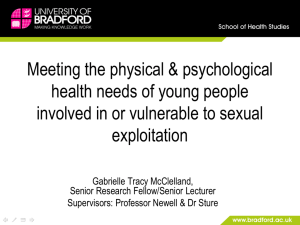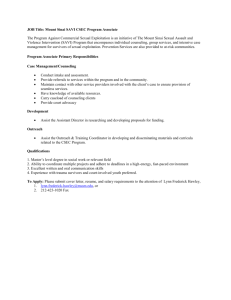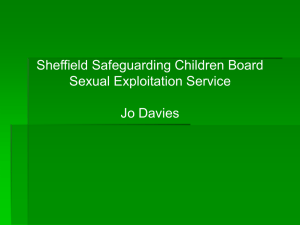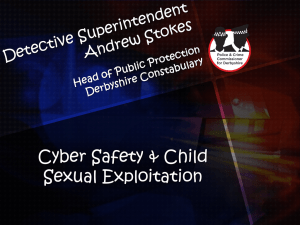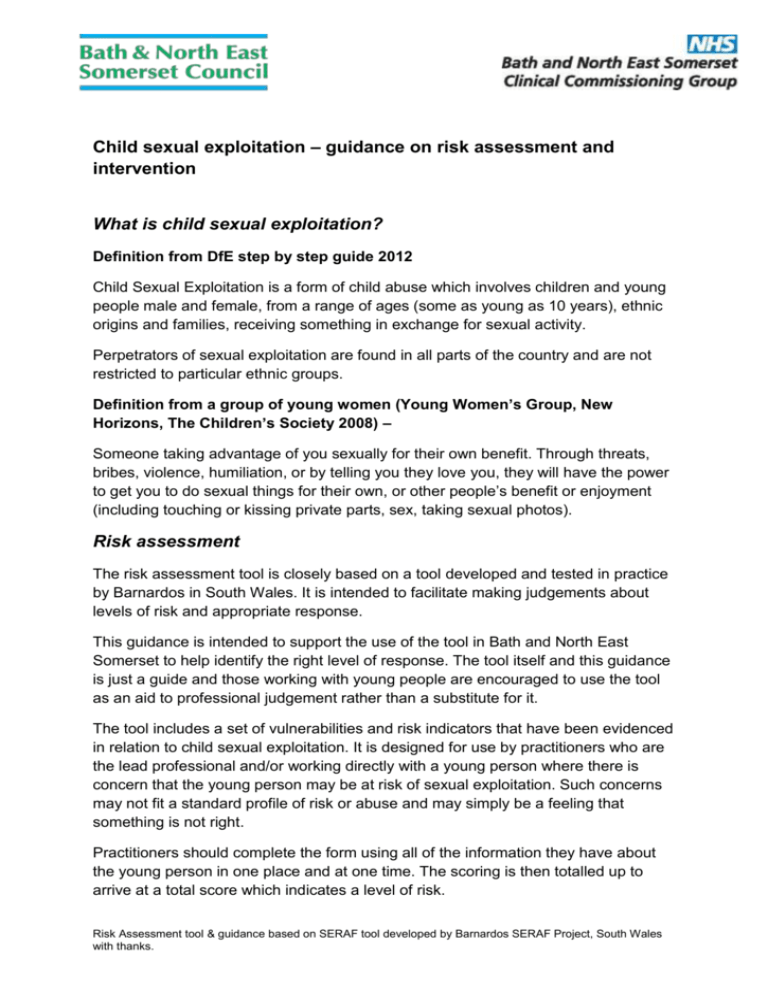
Child sexual exploitation – guidance on risk assessment and
intervention
What is child sexual exploitation?
Definition from DfE step by step guide 2012
Child Sexual Exploitation is a form of child abuse which involves children and young
people male and female, from a range of ages (some as young as 10 years), ethnic
origins and families, receiving something in exchange for sexual activity.
Perpetrators of sexual exploitation are found in all parts of the country and are not
restricted to particular ethnic groups.
Definition from a group of young women (Young Women’s Group, New
Horizons, The Children’s Society 2008) –
Someone taking advantage of you sexually for their own benefit. Through threats,
bribes, violence, humiliation, or by telling you they love you, they will have the power
to get you to do sexual things for their own, or other people’s benefit or enjoyment
(including touching or kissing private parts, sex, taking sexual photos).
Risk assessment
The risk assessment tool is closely based on a tool developed and tested in practice
by Barnardos in South Wales. It is intended to facilitate making judgements about
levels of risk and appropriate response.
This guidance is intended to support the use of the tool in Bath and North East
Somerset to help identify the right level of response. The tool itself and this guidance
is just a guide and those working with young people are encouraged to use the tool
as an aid to professional judgement rather than a substitute for it.
The tool includes a set of vulnerabilities and risk indicators that have been evidenced
in relation to child sexual exploitation. It is designed for use by practitioners who are
the lead professional and/or working directly with a young person where there is
concern that the young person may be at risk of sexual exploitation. Such concerns
may not fit a standard profile of risk or abuse and may simply be a feeling that
something is not right.
Practitioners should complete the form using all of the information they have about
the young person in one place and at one time. The scoring is then totalled up to
arrive at a total score which indicates a level of risk.
Risk Assessment tool & guidance based on SERAF tool developed by Barnardos SERAF Project, South Wales
with thanks.
Vulnerabilities
These factors may make a child or young person vulnerable to being targeted and
are scored 1 for each vulnerability.
Moderate risk indicators
These indicators are associated with risk of or may indicate abuse through sexual
exploitation. They should be ticked if present currently or in the last 6 months, and
each is scored 1.
Significant risk indicators
These indicators are very prevalent where a child or young person is at risk of or is
being abused through sexual exploitation. It is important to know whether the
indicator is current (on the date of assessment or in the last six months) or recent (612 months ago). If current each indicator is scored 5, if 6-12 months ago but not
since the indicator is scored 1. If an indicator is both current and was also present 612 months ago then both columns should be ticked, giving a score for that indicator
of 6.
The total score for the whole risk assessment tool indicates levels of risk and
response as follows.
Score 0-5 – not at risk of sexual exploitation
A child or young person who may be ‘in need’ but not currently at risk of being
groomed for sexual exploitation.
No change in previous level of intervention (universal, targeted, specialist services)
required. No multi-agency forum required if not already in place to address other
needs.
The worker who carried out the CSE assessment should ensure the child/young
person has education to stay safe.
The CSE risk assessment should be repeated if there is any significant change in
circumstances that might affect the level of risk of CSE.
Score 6-10 – mild risk of sexual exploitation
A vulnerable child or young person who may be at risk of being groomed for sexual
exploitation.
This level of risk is at level 2 or 3 of the early help offer in B&NES and tier 1 (targeted
support) of the social care threshold document.
Risk Assessment tool & guidance based on SERAF tool developed by Barnardos SERAF Project, South Wales
with thanks.
Targeted services through CAF and team around the child should be considered and
informed by the CSE assessment if not already in place. Consideration of the level of
response by the interface panel may be helpful. The CSE assessment should inform
planning and review if child already worked with by social care.
The lead professional or a member of the team around the child who has a good
working relationship with them should do a specific piece of work on risk awareness
and staying safe.
The CSE risk assessment should be repeated if there is any significant change in
circumstances that might affect the level of risk of CSE.
Score 11-15 – moderate risk of sexual exploitation
A child or young person who may be targeted for opportunistic abuse through
exchange of sex for drugs, accommodation (overnight stays) and goods etc.
This level of risk is at level 3 or 4 of the early help offer in B&NES and tier 2
(combined support) of the social care threshold document.
Referral to social care for assessment should be made if not already receiving a
social care service.
The young person should be referred to the risk management panel for discussion at
that level. This discussion should determine the most appropriate on-going
arrangement for multi-agency planning and review as well as outlining the actions
required.
A planned piece of work on risk reduction and keeping safe should be undertaken
with the young person by a worker who has a good relationship with them from
within the team around the child – this does not necessarily need to be the social
worker although it could be. Referral to an independent specialist service may be
considered if this is seen as most likely to achieve success.
Score 16+ - significant risk of sexual exploitation
Indication that a child or young person is at significant risk of or is already being
sexually exploited. Sexual exploitation is likely to be habitual, often self-denied and
coercion/control is implicit.
This level of risk is at level 4 of the early help offer in B&NES and tier 3 (specialist
support) of the social care threshold document.
Referral to social care for assessment should be made if not already receiving social
care service.
Risk Assessment tool & guidance based on SERAF tool developed by Barnardos SERAF Project, South Wales
with thanks.
The young person should be referred to the risk management panel for discussion at
that level. This discussion should determine the most appropriate on-going
arrangement for multi-agency planning and review as well as outlining the actions
required.
A planned piece of long term intensive direct work should be undertaken with the
young person by a worker who has a good relationship with them from within the
team around the child – this does not necessarily need to be the social worker
although it could be. Referral to an independent specialist service should be
considered if this is seen as most likely to achieve success.
Prevention and intervention
All children and young people need access to basic information that will enable them
to develop an awareness of the risks that can lead to a situation in which they may
be exposed to sexual exploitation. The school PSHE curriculum will provide this for
some but not all young people.
Young people in contact with targeted or specialist services are likely to have some
vulnerabilities and practitioners working with them are well placed to make sure they
have information that will equip them to avoid risk situations and to protect
themselves. This should be done even if a young person is assessed as not being at
risk of sexual exploitation.
At a mild level of risk planned work to raise awareness of sexual exploitation and to
provide tools for the young person to self-protect is indicated. This should be done
by someone who has a good working relationship with the young person. It should
include coverage of the risks of staying out late and going missing from school,
home or care.
At moderate or significant levels of risk work is required to focus on reducing specific
risks identified in the risk assessment, in particular staying out late and/or going
missing. As well as focusing on the most risky or dangerous areas of concern work
should address those areas identified by the child or young person as areas where
they are willing to work on making changes. The risk assessment tool can be useful
as a tool for discussing risks with the young person, to enable self-assessment and
compare their own understanding of their situation with that of the worker.
Work must be coordinated and synchronised between all agencies involved to
maximise its effectiveness and impact. There should be a consistent agreed
approach that does not shy away from or collude with risky behaviour. Young people
with many vulnerabilities and risks may be difficult to engage and achieving positive
engagement and outcomes can take time. This requires persistence and may require
significant effort to be spent by a worker on relationship building.
Risk Assessment tool & guidance based on SERAF tool developed by Barnardos SERAF Project, South Wales
with thanks.
A relationship needs to be developed which offers something tangible to the young
person. However it must be acknowledged that this is not a friendship and this is a
professional relationship. Change needs to happen at the young person’s pace,
providing real choices and promoting a sense of positive control for the young
person. The approach needs to be non-judgemental and ‘unshockable’. There is a
need to be consistently honest and to listen to and respect young people’s views.
Intervention begins with relationship building and assessment of risks and
vulnerabilities with the young person
Honest discussions and inclusion in assessment and planning processes will
help the child/young person to feel included, and create a sense of ownership
and connection with the plan
The plan should address each of the identified areas of risk
Workers need to be realistic about expectations and to understand that this is
long term intensive work.
Risk Assessment tool & guidance based on SERAF tool developed by Barnardos SERAF Project, South Wales
with thanks.

